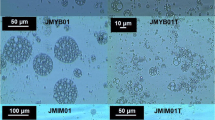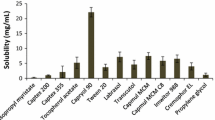Abstract
The purpose of this study was to formulate itraconazole and ketoconazole as oil/water emulsions for parenteral delivery by using a solvent-free homogenization process, namely SolEmuls (solubilization by emulsification) technology. The drugs were incorporated in the commercial emulsion Lipofundin MCT 20%, composed of a medium-chain triglyceride/long-chain triglyceride (MCT/LCT) oil phase (1∶1) and stabilized with 1.2% lecithin. Different parameters such as drug-loading capacity, long-term physical stability, and completeness of drug dissolution were investigated. Up to 10.0 mg/mL complete drug dissolution was achieved with itraconazole; at 20 mg/mL hybrid dispersion was obtained. Itraconazole-loaded emulsions were physically stable for 9 months (data up to now). Ketoconazole showed physical instability in the Lipofundin emulsion, which was stabilized with only 1.2% lecithin. Stabilization of ketoconazole-loaded emulsions was achieved using additionally Tween 80 as steric stabilizer. Higher concentrations of ketoconazole (ie, 10.0 mg/mL concentrated ketoconazole emulsions) were also produced with additional 2.0% Tween 80. Ketoconazole-loaded emulsions, 1 mg/mL, which were stabilized with 2.0% Tween 80, were stable for a period of 6 months. It can be concluded, after formulating amphotericin B and carbamazepine with SolEmuls technology, that SolEmuls was also applicable to the antimycotic agents itraconazole and ketoconazole, yielding IV-applicable emulsions with cost-effective production technologies.
Similar content being viewed by others
References
Nyström C. Dissolution properties of poorly soluble drugs: Theoretical background and possibilities to improve the dissolution behaviour. In: Benita S, Müller RH, Böhm BHL, eds.Emulsions and Nanosuspensions for the Formulation of Poorly Soluble Drugs. Stuttgart, Germany: Medpharm Scientific Publishers; 1998:143.
Thompson DO. Solubilizing Difficult Compounds, Give Them a Chance. In: 7th Annual Drug Delivery Partnerships Conference/Institute for International Research (IIR), Vol B4 (Workshop 1); January 28–30, 2003; San Diego, CA.
Jung YJ, Yoo SD, Lee SH, Kim KH, Yoon SD, Lee KH. Enhanced solubility and dissolution rate of itraconazole by a solid dispersion technique.Int J Pharm. 1999;187:209–218.
Frömming KH. Cyclodextrine-eine vielseitig verwendbare Gruppe neuer Hilfsstoffe. In: Müller RH, Hildebrand GE, eds.Pharmazeutische Technologie: Moderne Arzneiformen. Stuttgart, Germany: Wissen-schaftliche Verlag GmbH; 1998:13–17.
Schmitt J. Parenterale Fettemulsionen als Arzzneistoffträger. In: Müller RH, Hildebrand GE, eds.Pharmazeutische Technologie: Moderne Arzneiformen. Stuttgart, Germany: Wissenschaftliche Verlag GmbH; 1998:137.
Kirsh R, Goldstein R, Tarloff J, Parris D, Hook J, Hanna N. An emulsion formulation of Amphotericin B improves the therapeutic index when treating systemic murine candidatisis.J Infect Dis. 1998;158:1065–1070.
Caillot D, Casasnovas O, Solary E, Chavanet P, Bonnotte B, Reny G. Efficacy and tolerance of an amphotericin B lipid (Intralipid) emulsion in the treatment of candidaemia in neutropenic patients.J Antimicrob Chemother. 1993;31:161–169.
Shadkhan Y, Segal E, Bor A, Gov Y, Rubin M, Lichtenberg D. The use of commercially available lipid emulsions for the preparation of Amphotericin B-lipid admixtures.J Antimicrob Chemother. 1997; 39:655–658.
Davis SS, Washington C. Drug emulsion. European Patent ZA8804513. March 29, 1989.
Müller RH. Dispersions for the formulation of slightly or poorly soluble agents, DE 100 36 871 9, (2000), PCT application PCT/EP01/08726. 2001.
Müller RH, Schuhmann R.Teilchengrößenmenssung in der Laborpraxis. Stuttgart, Germany: Wissenschaftliche Verlag GmbH; 1997;38:65–66.
Müller RH.Zetapotential und Partikelladung in der Laborpraxis. Stuttgart, Germany: Wissenschaftliche Verlag GmbH; 1996;37:179.
Müller RH, Heinemann S. Fat emulsions for parenteral nutrition. I. Evaluation of microscopic and laser light scattering methods for the determination of the physical stability.Clin Nutr. 1992;11:223–236.
Akkar A, Müller RH. Formulation of i.v. carbamazepine emulsions by SolEmuls Technology.Eur J Pharm Biopharm. 2003;55:305–312.
Martindale. 30th ed. London, UK: Pharmaceutical Press; 1993: 326.
Müller RH, Böhm BHL. Nanosuspensions. In:Emulsions and Nonosuspensions for the Formulation of Poorly Soluble Drugs. Müller RH, Benita S, Böhm BHL, eds. Stuttgart, Germany: Medpharm Scientific Publishers; 1998:153.
Schuhmann R.Physikalische Stabilität Parenterale Fettemulsionen, entwicklung eines Untersuchungschemas Unter Besonderem Aspekt Analytischer Möglichkeiten, inDepartment of Pharmaceutical Technology, Biotechnology and Quality Management. Berlin, Germany: Free University of Berlin; 1995.
Akkar A, Müller RH. Drug nanocrystals produced by high pressure homogenization. In:“Access of Therapeutics to the Brain” 8th UKICRS Symposium. Poster No. 12 January 10, 2003. Belfast, Ireland.
Müller RH, Schmidt S. SolEmuls techology for i.v emulsions of poorly soluble drugs: Amphotericin B. in 14th World Meeting on Pharmacentics, Biopharmaceutics and Pharmaceutical Technology. April 8–11, 2002. Florence, Italy.
Author information
Authors and Affiliations
Corresponding author
Rights and permissions
About this article
Cite this article
Akkar, A., Namsolleck, P., Blaut, M. et al. Solubilizing poorly soluble antimy cotic agents by emulsification via a solvenent-free process. AAPS PharmSciTech 5, 24 (2004). https://doi.org/10.1208/pt050124
Received:
Accepted:
Published:
DOI: https://doi.org/10.1208/pt050124




